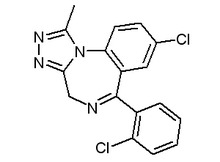The benzodiazepine triazolam is the most widely prescribed hypnotic agent in the United States. Because it has a short halflife, triazolam is less likely to cause resideual daytime effects and cumulative sedation afer multiple doses than hypnotic drugs with longer half-lives. However, triazolam may cayse daytime anxiety, increased impairment of memory, unusual behavioral effects and rebound insomnia. In the elderly, the clinical response to triazolam may be enhanced because of impaired metabolic clearance and resultant higher plasma concentrations. Greenblatt and collegues performed a study to determine the effect of age on the pharmacokinetics and pharmacodynamics of single doses of triazolam.
Twenty-six young subjects and 21 elderly subjects participated in the fourway crossover study. The mean age of the younger subjects was 30 years (age range: 21 to 41 years), and the mean age of the elderly subjects was 69 years (age range: 62 to 83 years). The subjects in both groups were healthy, active and ambulatory and had no evidence of medical illness or substance abuse. None were taking other medications.
All of these subjects underwent a single-blind trial with placebo. Then, in random order and in double-blind fashion, the subjects received single doses of placebo, 0.125 mg of triazolam and 0.25 mg of triazolam. At least one week elapsed between medication trials. For 24 hours after the administration of each of the three study medications, plasma triazolam levels were determined and psychomotor performance, memory and degree of sedation were assessed.
Peak plasma concentrations of triazolam were higher and the clearance rate lower in the elderly subjects. The degree of sedation was greater in elderly subjects than in young subjects receiving the same dose. Memory skills were tested 1.5 hours after administration of the drugs by having patients try to remember a list of 16 words. The ability to memorize the words was impaired in the elderly by both doses of triazolam, while memory in the younger subjects was only affected after receiving the larger dose. When free recall was tested 24 hours after medication was given, both young and elderly subjects had a significant loss of what had been learned at 1.5 hours. The relation of plasma levels of triazolam to the degree of impairment was similar in the two groups.
On the basis of these results, the authors recommend that initial doses of triazolam for otherwise healthy elderly persons be reduced by an average of 50 percent below the dose that would be prescribed for young persons of similar weight. Other clinical trials have verified the efficacy of 0.125 mg of triazolam in elderly patients with insomnia. (New England Journal of Medicine, June 13, 1991, vol. 324, p. 1691.)
COPYRIGHT 1991 American Academy of Family Physicians
COPYRIGHT 2004 Gale Group



